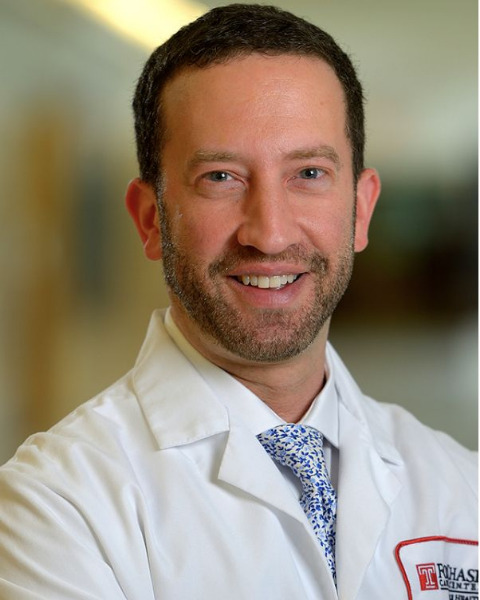Breast
CME
14: Should patients with HR+HER2- breast cancer and 1-3 positive sentinel nodes undergo axillary dissection to determine candidacy for abemaciclib?

Austin D. Williams, MD, MSEd (he/him/his)
Assistant Professor
Fox Chase Cancer Center
Philadelphia, Pennsylvania, United StatesDisclosure(s): No financial relationships to disclose

Austin D. Williams, MD, MSEd (he/him/his)
Assistant Professor
Fox Chase Cancer Center
Philadelphia, Pennsylvania, United StatesDisclosure(s): No financial relationships to disclose
- KR
Karen Ruth, MA
Data Analyst
Fox Chase Cancer Center, United StatesDisclosure information not submitted.
- MV
Mahtab Vasigh, MBBS
Research Fellow
Fox Chase Cancer Center, United StatesDisclosure information not submitted.
- MP
Mary Pronovost, MD
Associate Professor of Clinical Surgery
Fox Chase Cancer Center, United StatesDisclosure information not submitted.
- AA
Allison Aggon, DO
Associate Professor
Fox Chase Cancer Center, United StatesDisclosure information not submitted.
- AP
Andrea Porpiglia, MD, MSc
Assistant Professor
Fox Chase Cancer Center, United StatesDisclosure information not submitted.

Richard J. Bleicher, MD
Professor of Surgical Oncology; Leader, Breast Cancer Program; Director, Breast Fellowship Program
Fox Chase Cancer Center
Philadelphia, Pennsylvania, United StatesDisclosure information not submitted.
Abstract Presenter(s)
First Author(s)
Author(s)
The monarchE trial demonstrated improved disease-free survival with the use of adjuvant abemaciclib in high-risk HR+HER2- breast cancer (BC) defined as ≥4 positive lymph nodes (+LNs) or 1-3 +LNs with one or more additional high-risk features (HRF: tumor size ≥5cm, high grade, or Ki-67 ≥20%). We sought to investigate the proportion of patients with 1-3 positive sentinel lymph nodes (+SLNs) without HRF who went on to have ≥4 +LNs at the time of axillary lymph node dissection (ALND) and therefore qualify for abemaciclib.
Methods:
Using the National Cancer Database (2018-19), we identified females with pN+M0 HR+HER2- BC and stratified by number of +SLNs, +LNs, and the presence of HRF. We assessed the proportion of patients meeting criteria for abemaciclib in the overall cohort. Then, focusing on patients with 1-3 +SLNs without HRF who underwent ALND, we determined the proportion who had ≥4 +LNs and calculated the number of patients requiring ALND to identify one patient with ≥4 total positive LNs (number needed to treat: NNT).
Results:
Of the 22,048 patients identified, 14,626 (66%) met criteria for abemaciclib (6,948 had ≥4 +LNs, and 7,687 had ≥1-3 +LNs with HRF) while 7,422 (34%) had 1-3 +LNs without HRF and did not meet criteria for abemaciclib. Overall, 6% had undergone neoadjuvant therapy, and 54% underwent mastectomy. 16,305 patients had sentinel lymphadenectomy performed of whom 6,705 (41%) had 1-3 +SLNs with HRF. Of the 6,717 who had 1-3 +SLNs without HRF, 1,848 underwent ALND, and 325 (18%) ultimately had ≥4 +LNs. On subset analysis, the NNT was 11 for patients with 1 +SLN, 4 for those with 2 +SLN, and 2 for those with 3 +SLN (Table). Focusing on the 1,652 patients with 1-2+SLN without HRF (who, following Z0011/AMAROS and absent other indications, would not require ALND), ALND was performed exclusively to assess criteria for abemaciclib would constitute surgical overtreatment in 86% of patients. ALND omission would result in undertreatment with abemaciclib in 14% of patients.
Conclusions:
Patients with 1 +SLN without HRF are unlikely to have ≥4 +LNs and should not be subjected to the morbidity of ALND in order to inform indication for abemaciclib. Since ALND is standard for patients with 3 +SLNS, an individualized multidisciplinary discussion should be undertaken about the risks and benefits of ALND and abemaciclib for those with 2 +SLN. Further investigation is warranted into how to avoid undertreatment with abemaciclib in patients who do not otherwise require ALND.
Learning Objectives:
- Upon completion, participant will be able to list the criteria for adjuvant abemaciclib.
- Upon completion, participant will be able to discuss the probability of having additional positive axillary lymph nodes in patients with 1-3 positive sentinel nodes.
- Upon completion, participant will be able to discuss risks and benefits of axillary lymph node dissection and abemaciclib.
